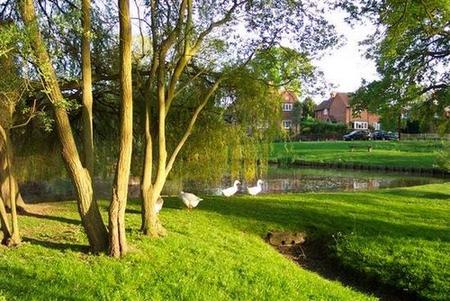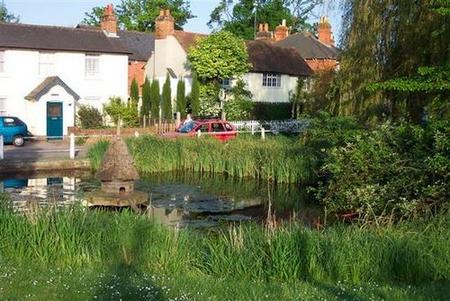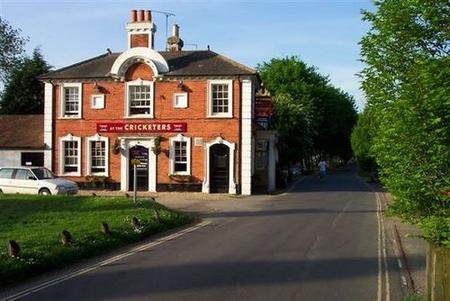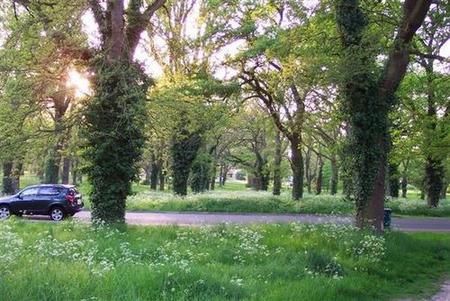History of Hartley Wintney Village – Tony Davies
![]()
The modern Hartley Wintney sits astride the A30 between Camberley and Basingstoke in Hampshire, but this was not always the case. Over nine hundred years ago, before the Norman Conquest, along with its twin parish of Elvetham it formed part of Earl Harold’s estate. A century later Hartley Wintney had become a separate manor owned by the Fitz Peters, who gave most of it to the Cistercians of Farnham, to found a Priory of Nuns (during King Richard 1’s reign) on Winta’s Island. Gradually the Priory acquired the rest of the village from the de Bendengs of Elvetham and the Herriards of Winchfield. For the next three hundred years Hartley Wintney was a typical mediaeval village, with its open fields clustered around the Manor Barn and the church on the hill overlooking the priory on its marshy island. During these times history was never far away. King John rode through the village on his way to Runnymede, to sign the Magna Carta. Simon de Montefort’s wife fed the local paupers. King David II of Scotland, son of Robert the Bruce, was imprisoned in nearby Odiham Castle..

In 1403 Henry IV gave William Esturmy a licence to enclose 300 acres within Elvetham Parish, as a park, and the peasants had to move outside the park fence where they have been ever since, retaining only a footpath to their Church in the Park. This edict triggered the foundation of Hartley Row as a community with a separate entity.
In 1535 Henry VIII came to Elvetham visiting his wife’s Maid of Honour, one Jane Seymour. The next year Anne Boleyn was beheaded and Jane became Queen of England. In 1537 Jane died after giving birth to Henry VIII’s only son Edward. He succeeded his father as Edward VI in 1547 at the age of 9 and his uncle Edward Seymour became the Regent of England. Forty years later Seymour’s son, the Earl of Hertford, entertained Anne Boleyn’s daughter, Queen Elizabeth at Elvetham, to obtain her pardon, but subsequently was sent to the Tower himself in 1595. The Tudors had finally destroyed the mediaeval peace of Hartley Wintney. It is interesting to consider that as the Queen progressed to the junction of the Odiham and Salisbury roads, by the Lamb Inn, she may have glanced over her shoulder and seen the Seymour’s inn with their Phoenix crest, in the distance. The Phoenix Inn and the Lamb still exist today as popular village hostelries.

During the Civil War the village was, for a time, in the front line while the Roundhead headquarters was based at Hartford Bridge.
In the more peaceful 18th century peace the village prospered. During this period the village focus moved down the hill to the coach road, now the A30, and a new causeway was built across the lake. Rich farmers and affluent newcomers like General Hawley, who lived at West Green House built large new houses. General Hawley, incidentally, became infamous because of his brutal treatment of Scottish fugitives from the Battle at Culloden in Scotland in 1745, and was thereafter called ‘Hangman’ Hawley. In 1770 a Cricket Club was formed in Hartley Wintney, which is one of the oldest in the country, and cricket has been played there ever since.
Between 1789 and 1794 the Basingstoke Canal was constructed to transport heavy loads between Basingstoke and London. Before this had a significant effect on the village the railway from Woking to Winchfield was constructed which provided better transport for goods and people. The passenger fare from London to Winchfield was 9 shillings First Class, and, 6 shillings Second Class for a journey taking 107 minutes. The railway helped the local farms and brought in the first commuters. Pessimists thought that the horse drawn coach trade would be ruined by the railway. A contemporary author wrote in 1846, “Hartley Row and Hartford Bridge have suffered greatly, as previously, coaches to and from the Metropolis passed hourly through them, in addition to which there were here a number of posting-houses in high repute”. At that time there were four coaches to London daily; the Telegraph, the Exeter, the Defiance and the North Devon. But, Hartley Wintney was not entirely dependant on the coaches, nor did they cease to run for several years after the railway reached Winchfield.

New industries grew up like Bird’s Tannery at West Green and William Cave’s brewery in Hartley Row. New shops, schools and chapels sprang up on both sides of the Row to serve the increased prosperity brought by the railway. Over the years of increased affluence and commerce businesses developed, and houses were built further away from the mediaeval village center and closer to the Turnpike road (the A30). By 1843 the Row was built up on both sides from ‘The Crown’ (opp. Park Corner) at the eastern end to Clarke’s Farm (opp. the Fleet Road) to the western end. Meanwhile, the agricultural prosperity of the Napoleonic wars led to some farmers becoming richer, while many of the smaller ones were edged out by the poor harvests and the effect of the Corn Laws of the post-war years. There were changes too, between the Row and the old mediaeval village of Hartley Wintney: cottages had been built around the green, where cricket was thriving since being introduced in the late 1700’s. there was now a lock-up and engine house for the primitive fire-engine (built 1830), a pound for stray animals, and a school. One building showed the seamier side of the agricultural revolution, the Workhouse, built in 1835, near the road to Hartford Bridge In the 1841 census there were 78 paupers out of an adult population of 800.
The main difference about Victorian times and today is that there was no St John’s Church (until 1870), no golf course, no lake, no Hunts Common apart from The Elms (now The Old Manor House), and no Phoenix Green apart from the Tollgate, the Cottage and the Phoenix Inn.

St Mary’s was displaced as the parish church in 1870 and so was unspoiled by later restoration. Nave and chancel date from the 13th century, north and south transepts were added early in the 19th and the present flint tower was built in 1842. Early 19th century pews and galleries fill the charming interior; the chancel fittings are earlier. There are good hatchments and a Royal Arms dated 1705. Wall paintings have been revealed in parts of the church.
One of the best known features of the village is the Mildmay Oaks. In 1805 the British Fleet defeated the combined navies of France and Spain at Trafalgar in one of the most significant battles of the Napoleonic War. Following this battle Admiral Collingwood, who had fought at Trafalgar, asked landowners to plant oak trees to provide timber for the nation’s future naval ships. In response to this Lady St John Mildmay planted the oak trees that are still a feature of the village today. The oaks have never been used because ship building technology developed in the industrial revolution overtook the initiative with the progression to iron ships.
The area is home to around 100 listed buildings. In keeping with its historical associations the village is more recently famous for its connections with the antique trade. Today with its golf, cricket, football and a miscellany of other clubs, local shops, good local amenities such as the Victoria Hall community complex, and rural surroundings, Hartley Wintney is one of the more desirable places to live in Hampshire.
Hence, Hartley Wintney’s unique claim to remain a village. It has survived the Normans, the Tudors, the Roundheads, and the Railway. What other village has so mirrored England’s history first as a monastic village with open fields, then as an 18th century coaching and farming center, and finally as a twentieth century commuter’s haven ? What other village can still show the legacy of each period around it for those with eyes to see ? The mediaeval open fields, the church, the duck pond, the remains of the Priory, the 18th century brick houses, the coach bridge, the row of shops to serve the coaches, and the village cricket green that was sending players to bat for England before Nelson fought Trafalgar; they are all still here.
I would like to acknowledge with many thanks the permisson of Hartley Wintney Preservation
Society for allowing me to use extensive material from David Gorsky’s book, The Old Village of
Hartley Wintney published by the Hartley Wintney Preservation Society, 1985 in the compilation
of this short history of Hartley Wintney.
Source: Tony Davies HWTA
November 2008.

